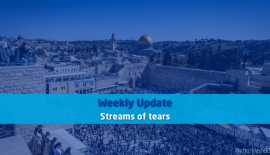Analysis: Israel’s Security Situation
The assassination of Qassem Soleimani, the commander of the Quds Force of the Islamic Revolutionary Guards Corps (IRGC), and Abu Mahdi al-Muhandis the commander of the Kata’ib Hezbollah militia and the deputy commander of the al-Hashd al-Sha’abi organisation of predominantly Shiite militias in Iraq, caused a significant change in the war that Israel is fighting against Iran.
At the end of 2019, Aviv Kohavi, the Chief of Staff of the Israel Defense Forces (IDF), indicated during a security conference in Herzliya, that Israel wasn’t satisfied with the fact that it was fighting Iran’s imperialistic drive in the Middle East alone.
But, on 3 January, came the American drone attack that killed Soleimani, a national hero in Iran, and al-Muhandis who had more than 40 years of experience in asymmetric warfare against foreign actors in Iraq.
The assassination changed the whole strategic situation in the war against Iran and its numerous proxies and Israel’s case for the better.
Until 3 January, Israel carried out more than 1,000 air strikes against Iran-related targets in Syria while the Israeli air force (IAF), in 2019, widened its attacks against the Iranian axis to Iraq where Soleimani was arming the al-Hashd al-Shaabi militias with ballistic missiles that could reach Israel.
At the same time, the Quds commander was interfering in Iraqi politics and tried to establish a new, pro-Iranian government that would force the US army out of Iraq; a plan that would also have repercussions for Israel since the US military in Iraq was cooperating with Israel in the field of intelligence.
Israel isn’t alone anymore in the fight against the Iranian axis now that the US has entered the fray.
Soleimani, however, overplayed his hand when he ordered attacks on US targets in Iraq which eventually resulted in the death of an American engineer in Iraqi Kurdistan and the wounding of four US soldiers.
The Iranian general also engineered violent attacks on the US embassy in Baghdad. This together with a reported plan to attack additional US embassies in the Middle East, caused US President Donald Trump to okay the assassination of Soleimani and his Iraqi sidekick al-Muhandis.
The Iranian response came in the form of a missile attack on two US bases in Iraq that only lightly wounded nine American soldiers. This was followed by new mysterious airstrikes on pro-Iranian militias in the area of the border town of al-Bukamal on the Syrian Iraqi border.
Arab media reported that this time the airstrikes were contributed to by the US-led coalition that used to fight Islamic State and not the IAF.
The airstrikes marked the first time the US army directly confronted the Iranian axis, and they could be a game- changer in the war against Iran.
In one month’s time, Iran lost the high ground it had in its imperialistic drive to take over the Middle East.
It lost Soleimani, the shrewd architect of the Shiite Crescent project, a man whom Israel regarded as its biggest foe and who was actively preparing for war against the Jewish state by forming a coalition of proxy forces that included Hezbollah in Lebanon, Shiite militias in both Syria and Iraq, the Ansar Allah or Houthi militia in Yemen, and Palestinian Islamic Jihad and Hamas in Gaza.
These militias and terror organisations received massive amounts of weapons and money from Soleimani as well as militarray as became apparent by reports about the chaos in the Hashd al-Sha’abi organisation in Iraq. Another indication that the pro-Iranian axis is suffering from a leadership vacuum is the fact that Hezbollah leader, Hassan Nasrallah, is trying to raise his profile by making comments indicating that he would like to take over Soleimani’sary training in Lebanon, Syria, and Iraq. Iran reportedly also delivered long-range missiles to Ansar Allah in Yemen that were supposed to be used against southern Israel and the Gulf of Eilat, a very important waterway for Israel.
With Soleimani and al-Muhandis gone the pro-Iranian axis seems to be in disarray as became apparent by reports about chaos in the al-Hashd al-Sha’abi organization in Iraq. Another indication the pro-Iranian axis is suffering from leadership vacuum is the fact that Hezbollah leader Hassan Nasrallah is trying to raise his profile by making comments indicating he would like to take over Soleimani’s role.
The Hezbollah leader lacks the skills of Soleimani, however, and is not able to travel around freely in the Middle East since Israel is looking to assassinate him.
To conclude, Israel isn’t alone anymore in the fight against the Iranian axis now that the US has entered the fray. The axis doesn’t have a leader like Soleimani anymore and the regime in Iran has been weakened not only by Soleimani’s death but also, by the popular uprising that followed the tragic shoot-down of a Ukrainian civilian plane in Iran.






